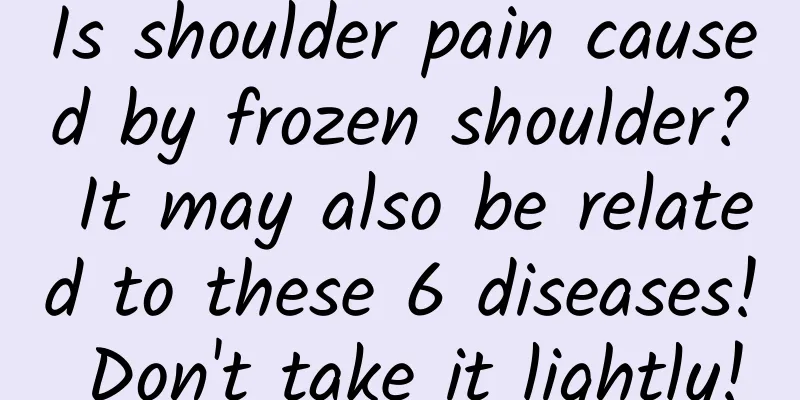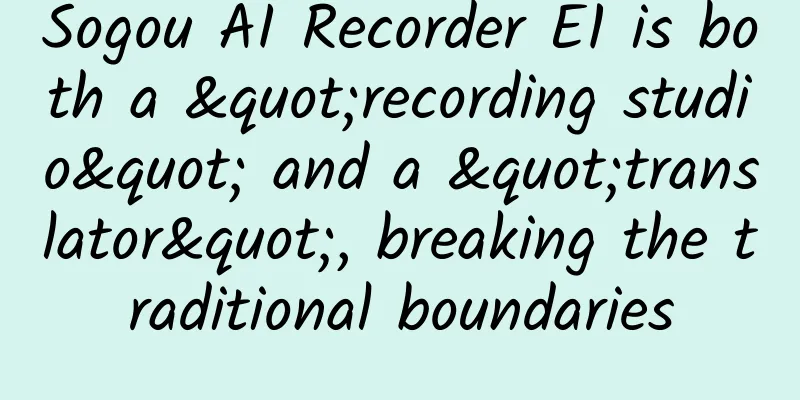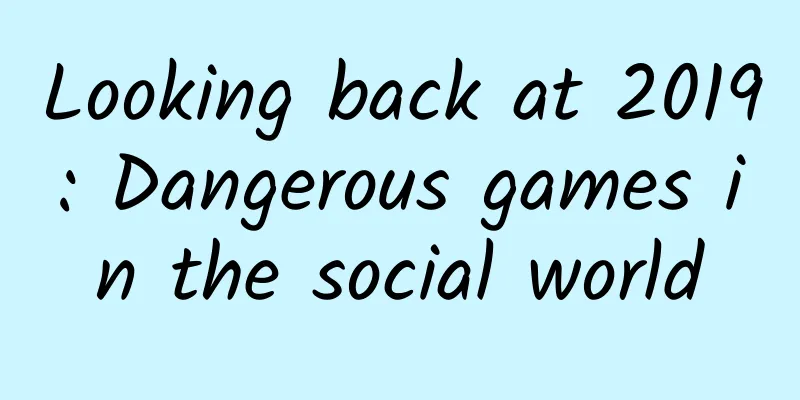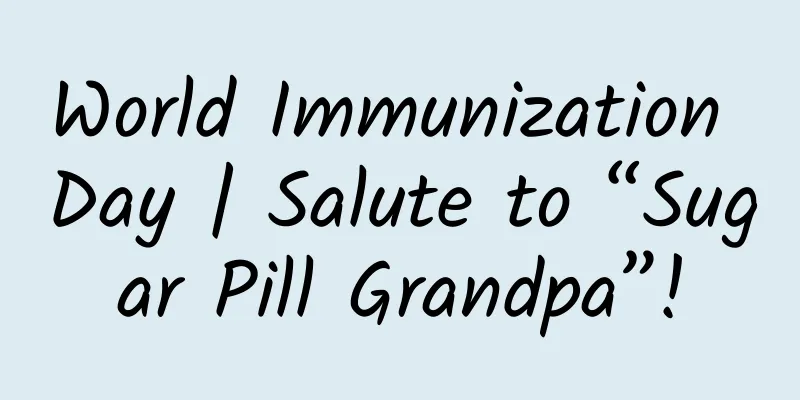Is shoulder pain caused by frozen shoulder? It may also be related to these 6 diseases! Don't take it lightly!

|
"Doctor, I have had severe shoulder pain recently. Could I have frozen shoulder?" I am often asked this question by patients when I am seeing patients in the outpatient clinic. The name "periarthritis of shoulder" is deeply rooted in the minds of doctors and patients. Almost all shoulder pain and movement disorders are called "periarthritis of shoulder". In fact, the incidence of "periarthritis of shoulder" is very low. Most shoulder pain may not be "periarthritis of shoulder"! It may be "rotator cuff injury", and the proportion of periarthritis of shoulder is very small. So what is periarthritis of shoulder and what is rotator cuff injury? Copyright image, no permission to reprint 01 What is frozen shoulder? Periarthritis of the shoulder, also known as "frozen shoulder", is shoulder pain and dysfunction caused by inflammatory changes in the soft tissues (synovium, joint capsule and ligaments) around the shoulder joint. The European and American Orthopaedic Association defines frozen shoulder as a type of adhesive capsulitis that causes stiffness of the glenohumeral joint, manifested by pain around the shoulder joint, decreased active and passive range of motion in all directions of the shoulder joint, and no obvious abnormalities in radiological examinations except for decreased bone mass. Magnetic resonance imaging often shows mottled long T1 and long T2 signals inside the shoulder joint and in the soft tissue spaces around the shoulder joint, indicating that there is inflammation and edema here. Who is prone to frozen shoulder? Frozen shoulder is common in middle-aged and elderly people aged 40 to 70, with a prevalence rate of 2% to 5% in this age group. It is more common in women than in men, and there is no significant difference between the left and right hands. Patients with diabetes, cervical spondylosis, ischemic heart disease, hyperthyroidism, chest lesions, trauma and other diseases have a slightly higher chance of suffering from frozen shoulder. 02 How to determine whether you have frozen shoulder? Basic judgment First, the age of the patients is mostly middle-aged and elderly. Secondly, the onset is slow, the shoulder pain gradually worsens, the shoulder external rotation becomes difficult, and the shoulder joint soon becomes stiff, and movement in all directions is limited. Moreover, there is no numbness or other sensory impairment in the limbs. It can be relieved on its own after about 3 months to half a year. Simple judgment This does not apply to adolescents with shoulder pain and no history of shoulder trauma, those with intermittent and recurrent pain, those with unrestricted early shoulder external rotation (the hand can touch the back of the head), those with no stiff shoulder joints in the later stages, those with numbness in the shoulders and arms, and middle-aged and elderly people with a clear history of shoulder trauma, such as proximal humeral fractures. 03 How to treat frozen shoulder? The primary goals of treatment for frozen shoulder are to relieve pain and restore range of motion. Drug treatment Non-steroidal drugs (Celebrex, Fenbid, Voltaren, Ibuprofen, etc.) and pain point blocking can effectively and quickly relieve pain. Infrared and microwave therapy It can improve local blood supply and promote the dissipation of inflammation. Shoulder Massage Therapy There are also certain effects, but the technique should be gentle and stop when it is enough. Do not use violence! Otherwise, it is easy to cause fractures and secondary injuries. Copyright image, no permission to reprint Shoulder joint function exercises The key measure of treatment, no matter which treatment method is used, must be combined with functional exercise. This is different from rotator cuff injury, which will be discussed later. Arthroscopic shoulder release surgery For patients with a long course of illness, severe pain, poor response to conservative treatment, and serious impact on work and life, arthroscopic shoulder release surgery can be chosen. 04 If shoulder pain is not frozen shoulder, what disease is it? In fact, the most common cause of shoulder pain is rotator cuff injury caused by shoulder impingement or senile degeneration . The rotator cuff is a general term for the tendon tissues such as the subscapularis, supraspinatus, infraspinatus, and teres minor that cover the front, top, and back of the shoulder joint. Its main function is to lift the shoulder. Rotator cuff injury will weaken or even lose this function, seriously affecting the abduction function of the upper limb. Among them, the supraspinatus tendon located above the shoulder joint is most likely to be injured. Therefore, the disease often occurs in sports enthusiasts who engage in repetitive sports that require extreme abduction of the shoulder joint (such as baseball, freestyle, backstroke and butterfly stroke, weightlifting, and racket sports). As middle-aged and elderly patients age, simply engaging in simple daily activities may also cause changes in the rotator cuff, such as thinning of the tendon or insufficient blood supply, leading to aging and degeneration of the rotator cuff, resulting in damage or rupture. 05 What are the characteristics of rotator cuff injury pain? Many patients experience severe pain immediately after shoulder injury, but the pain is relieved the next day and then worsens the next day. Many people may also experience pain at night, which affects their sleep and even wakes them up at night. Some patients with rotator cuff injuries experience the most obvious pain when they straighten their arms and rotate them inward (also known as the empty cup experiment, the action of taking a cup of water and emptying the cup) and stretch outward to a certain extent, and then disappear (pain arc). Among them, "night pain" is a unique feature of rotator cuff injury. If you wake up with shoulder pain at night, or the pain affects your sleep, it is likely that you have a rotator cuff injury and need to go to the hospital for examination and treatment. Copyright image, no permission to reprint 06 How are rotator cuff injuries diagnosed? X-ray examination The morphology of the acromion and the bony structure of the shoulder joint can be determined. Some patients with rotator cuff injuries have obvious bone hyperplasia and calcific tendinitis at the anterolateral edge of the acromion and the greater tuberosity. Magnetic resonance imaging (MRI) MRI can clearly show the cartilage, joint capsule, ligament, tendon, muscle and other structures of the joint, and is the best means of diagnosing joint injuries and diseases. It can help confirm whether there is damage to the rotator cuff structure, the specific location and severity of the damage, especially magnetic resonance imaging (MRA) can clearly show partial tears of the rotator cuff, which is of high value for diagnosis. B-ultrasound Musculoskeletal ultrasound can diagnose muscle injuries, muscle inflammation, tendon ligaments, fascia and other injuries. Rotator cuff injuries can be clearly shown, but this has a lot to do with the operator's professional level and understanding. 07 What happens if a rotator cuff injury is not treated? First, the recurring pain affects work, life and daily activities. The rotator cuff is a structure composed of the tendons of four muscles to maintain the stability of the shoulder joint. Only a healthy rotator cuff can assist other movement structures to complete various postures and movement functions of the upper arm. Second, when the rotator cuff is damaged, the entire shoulder joint will become very unstable, which will affect the function of the shoulder joint to a certain extent and increase the speed of shoulder joint degeneration. 08 How is a rotator cuff injury treated? Conservative treatment Patients with less severe injuries can choose conservative treatment. The most important thing is to immobilize and rest the shoulder. Unlike patients with frozen shoulder, such patients are not recommended to perform shoulder functional exercises, because this may aggravate the degree of rotator cuff injury. If the pain is obvious during the rest process, physical therapy and drug therapy can be combined. Physical therapy mainly includes ice compress, medium frequency electricity, low frequency electricity, short wave and ultrasound, etc. Different physical therapy methods are selected according to the different conditions of the patients. Surgery If the injury is severe, the rotator cuff is completely torn, or conservative treatment for 3 to 6 months is ineffective, surgical treatment is required. At present, arthroscopic rotator cuff suturing is mostly adopted. For patients who do not allow it or have severe injuries, small incision surgery can be selected. The specific type of surgery should be determined according to the patient's specific situation. After surgery, it is generally necessary to wear a protective gear for 6 to 12 weeks. During the wearing of the protective gear, functional rehabilitation training should be carried out under the guidance of professionals. Generally, active training is carried out after 6 weeks. After partial healing, manual traction and muscle strength training can be carried out under the guidance of a professional rehabilitation therapist, and then restorative training can be carried out to return to daily life and sports. Author: Guo Qinghua, attending physician of joint surgery, Shanghai Seventh People's Hospital Source: Big Doctor and Little Nursing The cover image and the images in this article are from the copyright library Reproduction of image content is not authorized |
<<: Is acupuncture scientific? What is its connection with the human body’s neural mechanism?
>>: "Losing weight" is a big deal! These 6 wrong ways to lose weight may ruin you
Recommend
Brazil World Cup promotes the popularity of 4K ultra-high-definition TV products
Despite the impact of the withdrawal of national ...
Sun Jiadong, Lu Yuanjiu...their names shine in the starry sky
This is Sun Jiadong, winner of the Medal of the R...
WeChat takes up too much memory? Here's how to free up your phone in two minutes
When it comes to communication and chatting softw...
Operator subsidy policy adjustment: mobile phone manufacturers face great challenges
Under the dual effects of reducing marketing expe...
The first "Metaverse" scam was exposed, claiming to have increased 18 times in 40 days, and many people have been fooled
The concept of "Metaverse" has inexplic...
Does Vinegar-Stir-fried Potato Shreds contain Slow-Digesting Starch? How to Eat Potatoes Without Surges in Blood Sugar?
Everyone knows that potatoes (scientific name Sol...
The dilemma Chinese Internet companies leave for Apple
[[124156]] On November 16, Sogou Number Lite iOS ...
Are the materials submitted for information flow advertising repeatedly rejected? You haven't learned this internal audit rule yet!
With the 19th National Congress of the Communist ...
Online Live Traffic Drainage Course Practical Manual
A high-conversion live class can bring hundreds o...
If your ears itch but you can't find anything to take out, beware of problems →
Audit expert: Peng Guoqiu Deputy Chief Physician,...
What are those little pimples around the eyes? Don't pull them, or they may cause big problems!
Expert of this article: Yan Ya, PhD in Medical Bi...
Yakeshi SEO Training: What traps should you avoid when exchanging friendly links?
In the process of website optimization, the const...
The truth about mooncakes: What kind of cake can be called a mooncake?
Written by Wei Shuihua Header Image | Who is the ...
How to quickly increase fans on Kuaishou? What should I pay attention to when increasing followers?
This article mainly introduces how to quickly inc...
Quick quiz: Are you right-brained or left-brained?
© Atlassian Leviathan Press: The "two-mind h...









